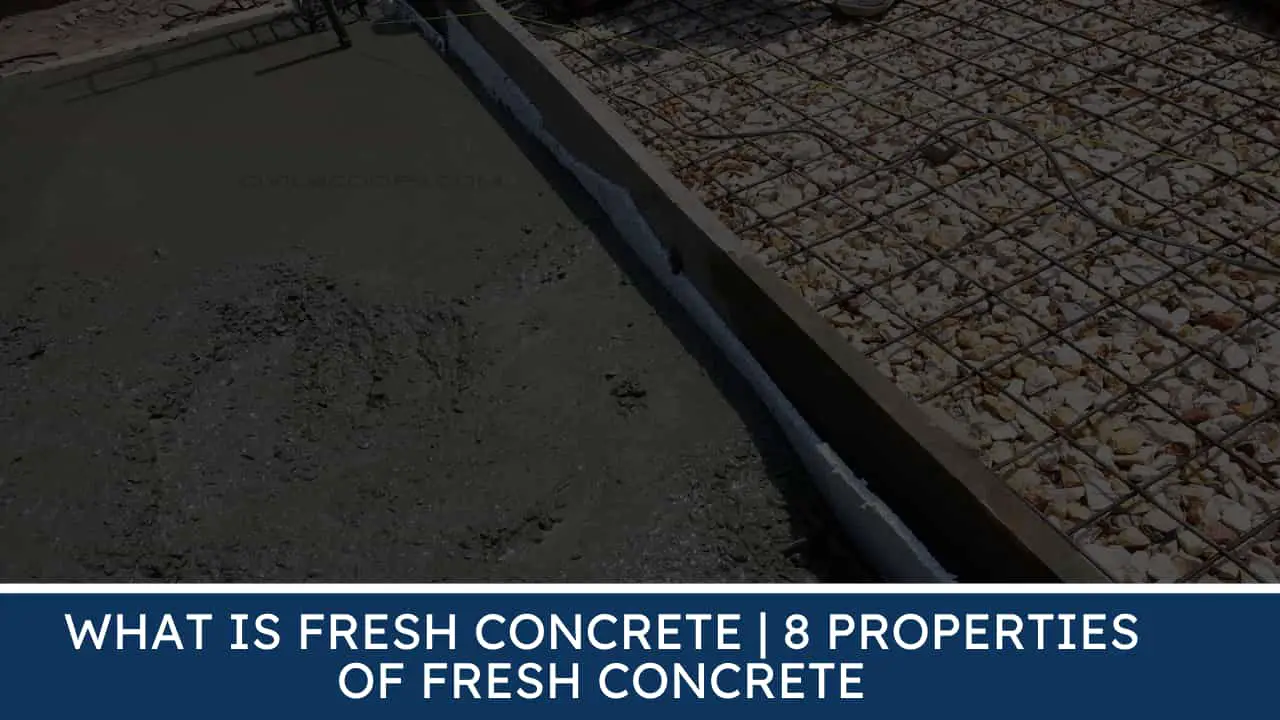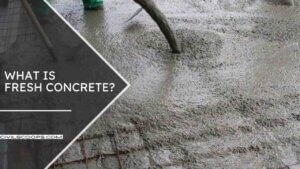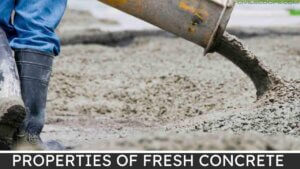What Is Fresh Concrete | 8 Properties of Fresh Concrete

Table of Contents
What Is Fresh Concrete?

When concrete is its plastic state, it is known as fresh concrete. Fresh concrete can be easily molded to a durable structural member. It can be prepared on the spot and may give a wide range of properties from easily available raw materials.
Properties of Fresh Concrete

- Workability.
- Temperature.
- Water Cement Ratio.
- Segregation.
- Bleeding.
- Plastic shrinkage.
- Setting Time.
- Hydration.
1. Workability of Fresh Concrete
The diverse requirements of transportability, compatibility, mobility, stability, mixability, playability, and finish ability of fresh concrete mentioned above are collectively referred.
To as workability. The workability of fresh concrete is thus a composite property. It is difficult to define precisely all the aspects of the workability in a single definition.
IS 6461 (Part-VII)-1973 defines workability as that Property of freshly mixed mortar or concrete that determines the ease and homogeneity by which it could be mixed, placed, compacted, and completed.
- Factors Affecting Workability
- Influence of Mix Proportions
- Influence of Aggregate Properties
- Influence of Admixtures
- Effect of Time
Test of Workability for Fresh Concrete
- Slump Test
- The Competing Factor Test
- The Vee-Bee Consistency Test
- The Flow Test
- Spread / Flow Table
- Kelly Ball
- Ouimet
- K- Slump
- Visual Assessment
2. Temperature of Fresh Concrete
Concrete is not recommended to be placed at a temperature above 40°C without proper precautions, as laid down in IS:7861(part -1).
Special problems are encountered in the preparation, placement, and curing of concrete in hot weather. The First 24 to 72 hours after placing fresh concrete are of extreme importance.
In this period, hydration of concrete occurs, which is a chemical process in which concrete gains its strength.
If the temperature of concrete is not controlled and it goes beyond maximum range during hydration, then stresses are produced, and cracks are formed in concrete.
Also if the temperature falls below the minimum temperature, then concrete takes a large time to set, and the hydration process slows down.
It is necessary to understand here that concrete can be done at any temperature unless the temperature is controlled.
3. Water Cement Ratio (w/c) of Fresh Concrete
It is the ratio of cement and water utilized in the preparation of concrete. The quantity of water used at mixing concrete is very important.
If the percentage of water used is less, then there will not be a sufficient quantity of water to hydrate cement. It will result in weak and porous concrete.
Therefore, the usual tendency is to use too much water that gives a more workable mix, but it doesn’t give sound concrete. Too much water results in the segregation of aggregates and gives porous concrete of low strength and low density.
A certain minimum proportion of water is necessary to hydrate the cement completely. To create the concrete sufficiently workable to be placed in position, some more water is needed.
So long as the concrete is sufficiently workable, for the way of placing used, its strength depends on the proportion of water to the cement in the mix.
The water-cement ratio shouldn’t be allowed to exceed the specified limits for various types of concrete and should usually be kept as low as the methods of placing will allow.
Abrahms, as a result of a large number of experiments, states that“with given materials and conditions of the test, the ratio of the quantity of mixing water into the quantity of cement alone determines the potency of concrete as long as the mix is of workable plasticity.“
This is known as water-cement ratio law. According to this law, the strength of concrete won’t increase by simply increasing the quantity of cement unless the water-cement ratio is reduced.
Water-Cement Ratio Table
[su_table responsive=”yes” alternate=”no”]
| IS 10262 | Minimum Cement Content | W/C Ratio | Grade | Minimum Cement Content | W/C Ratio | Grade |
| Mild | 220 | 0.6 | 300 | 0.55 | M20 | |
| Moderate | 240 | 0.6 | M15 | 300 | 0.5 | M25 |
| Severe | 250 | 0.5 | M20 | 320 | 0.45 | M30 |
| Very Severe | 260 | 0.45 | M20 | 340 | 0.45 | M35 |
| Extreme | 280 | 0.4 | M25 | 360 | 0.4 | M40 |
[/su_table]
4. Segregation of Fresh Concrete
Segregation is usually caused by excessive vibration of cement. The different materials that make up the concrete mix have different weights, so while the concrete is in a liquid state, there is a tendency for heavier materials to settle to the bottom, and the lighter slurry to rise to the top.
Isolation means the separation of newly designed solid ingredients from each other in a non-uniform mixture.
More specifically, it implies the separation of coarse aggregates from the mortar in which they are composed due to differences in the size, density, shape, and other properties of the material.
Due to the separation, the hive is made into concrete, and it basically affects the strength of the concrete and its porosity.
During concrete work, isolation in concrete can occur on-site, and this affects the durability of your structures. In fine concrete, all the ingredients are properly distributed and form a homogeneous mixture.
If a concrete sample exhibits a tendency to separate coarse aggregates from the rest of the material, it indicates the separation in the concrete.
Harmful Effects Due to the Segregation of Concrete
- To comb the concrete honey.
- The high permeability of concrete.
- Low compressive strength.
- Poor finishing of surfaces.
5. Bleeding of Fresh Concrete
Bleeding in concrete is sometimes referred to as water gain. This is a special form of separation, in which some water from the concrete flows to the surface of the concrete, with the lowest specific gravity among all concrete components.
Excessive bleeding is seen in thin members such as roof slabs or road slabs, and when the concrete is placed in sunny weather.
Prevention of bleeding in concrete
- Bleeding can be reduced with appropriate proportions and uniform and complete mixing.
- Bleeding is reduced by the use of finely divided pozzolanic materials, making a long way to cross the water.
- The air-penetrating agent is very effective for reducing blood.
- Bleeding can be reduced by the use of fine cement or cement with low alkali content.
6. Plastic Shrinkage of Fresh Concrete
If water is removed from the concrete before it sets, the volume of the concrete is reduced by the amount of water removed. This volume reduction is known as plastic shrinkage.
This is the shrinkage that the fresh concrete undergoes until it sets completely.
Water may be removed from the plastic concrete by evaporation or by being absorbed by dry surfaces such as soil or old concrete or by the dry wooden formwork.
7. Setting Time of Fresh Concrete
When concrete changes its state from fresh to hardened then this process is called setting. And the time required to complete this process is known as Setting Time of Concrete.
Setting time depends on the type of cement and it can be increase or decrease by adding admixture in concrete.
8. Hydration In Fresh Concrete
When cement comes in contact with water, a chemical reaction begins. This reaction is known as hydration.
If the mixing water dries out too rapidly before the cement has fully hydrated, the curing process will stop, and the concrete will not harden to its intended strength.
Hydration occurs more rapidly at higher air temperatures. Hydration itself also generates heat. This heat of hydration can be helpful during cold-weather construction but harmful during hot-weather construction.
[su_box title=”FAQ” style=”default” box_color=”#333333″ title_color=”#FFFFFF” radius=”3″ class=”” id=””]
Slump Cone Test
Concrete slump test or slump cone test is to determine the workability or consistency of concrete mix prepared at the laboratory or the construction site during the progress of the work. Concrete slump test is carried out from batch to batch to check the uniform quality of concrete during construction. The slump test is the most simple workability test for concrete, involves low cost and provides immediate results.
Slump Concrete Test
The concrete slump test measures the consistency of fresh concrete before it sets. It is performed to check the workability of freshly made concrete, and therefore the ease with which concrete flows. It can also be used as an indicator of an improperly mixed batch.
Hardened Concrete
Hardened concrete is a type of concrete that is strong and have the capacity to bear the structural as well as service loads that are applied to it. Hardened concrete is one of the strongest and durable construction materials. Hardened concrete is concrete that is completely set and able to take the loads.
Consolideck Ls
Consolideck® LS is a penetrating lithium silicate treatment that reacts with the concrete to produce insoluble calcium silicate hydrate within the concrete pores. Treated surfaces resist damage from water and surface abrasion. The increased surface hardness imparted by Consolideck LS eliminates dusting and simplifies maintenance producing a cleaner, healthier environment.
[/su_box]
[su_note note_color=”#F2F2F2 ” text_color=”#333333″ radius=”3″ class=”” id=””]
Like this post? Share it with your friends!
Suggested Read –
- What Is Shovel | Types of Shovels
- What are Traps | What Does Trap do | 14 Types of Traps In Plumbing
- All About Pier and Pile | Difference Between Pier and Pile | What Is Pier | What Is Pile
- All About Fish Ladder | What Is Fish Ladder | Types of Fish Ladder | Fish Ladders in Dams
- All About Rat Trap Bond | What Is Rat Trap Bond | How to Use | Advantage & Disadvantage of Rat Trap Bond
[/su_note]
Originally posted 2022-07-05 14:06:06.
